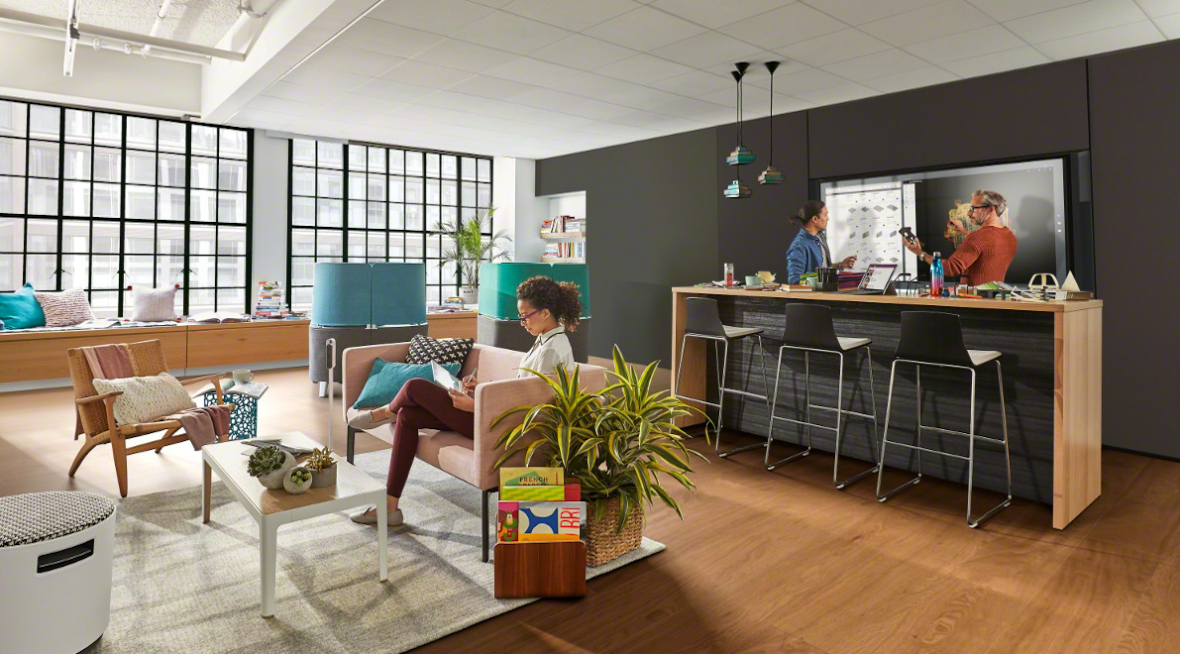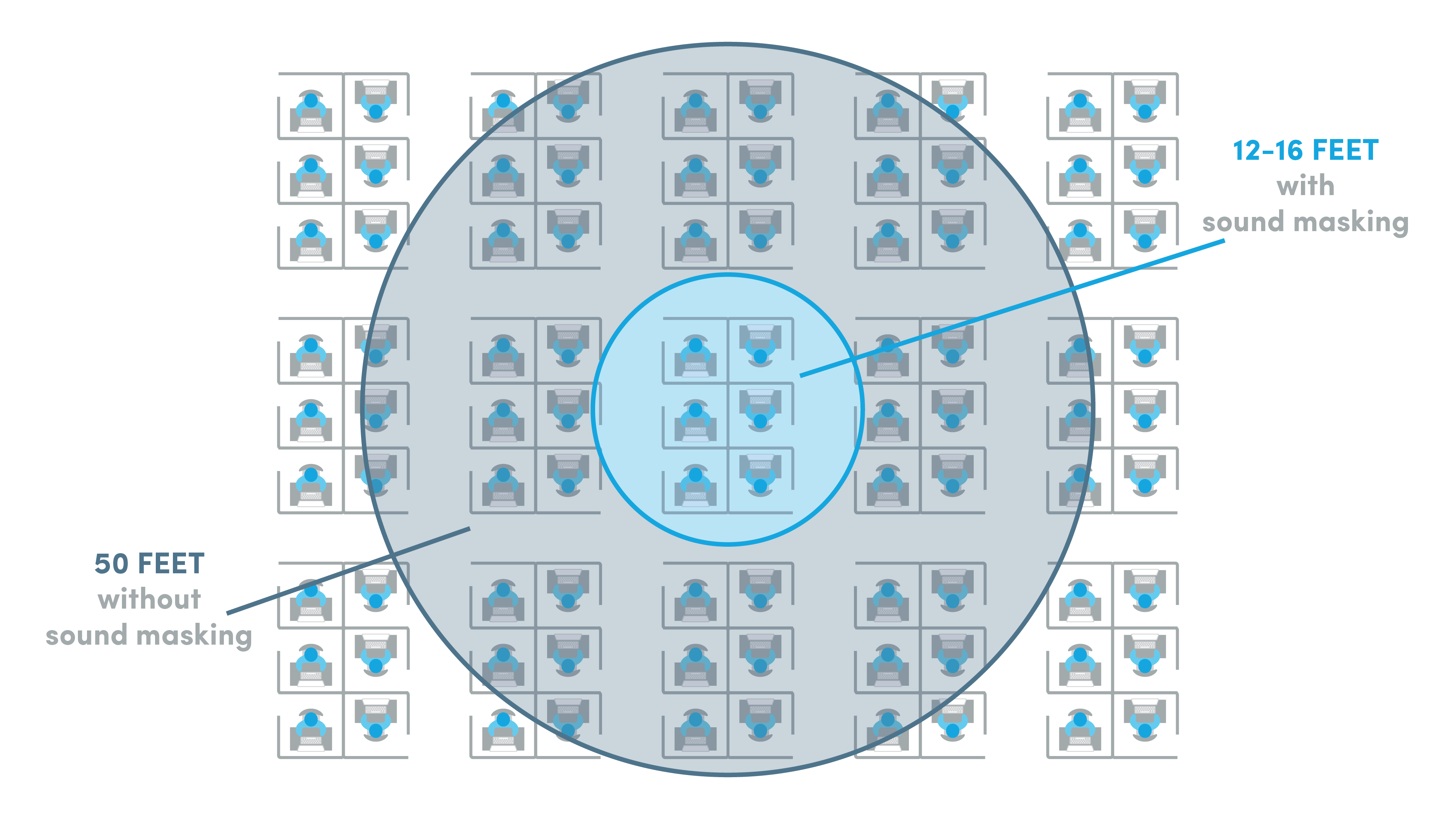We use cookies to maximize your online experience with us. By closing this window, you consent to our cookie policy. You can change your cookie settings in your browser any time. For more information, please see our Privacy Policy located on the footer of this site.
Decrease Distractions with Sound Masking Systems

Open space plans have created a need to reduce distractions and support speech privacy in any environment. As more organizations begin to understand the value achieved through speech privacy systems, they’re often faced with the same daunting question: how is it accomplished and where do I start?
Cover the noise with ambient sound
Sound masking is a simple, nonobtrusive way to combat the emerging challenge of acoustic privacy. While other methods consist of acoustic materials, physical walls, or partitions to absorb or block sound, sound masking systems typically consist of an array of loudspeakers installed above the ceiling. The system emits a soft, uniform, and inconspicuous background sound similar to the gentle flow of air. Adding a layer of sound on top of sound may seem counterintuitive, but it can actually make a space seem quieter. Using a wall interface to set the system to a comfortable ambient level, the sound acts to cover noise and fill in the structured sounds of human speech.
Your space might be too quiet
A space that’s too quiet can be just as distracting as one that’s noisy. When every footstep, whisper, crinkle of paper, or sniffle can be heard throughout the entire area, it too interferes with the ability to focus. A layer of properly calibrated sound will blend into the background and help cover noises so people are more comfortable and able to concentrate.
Sound masking supports speech privacy
By finding the right balance of ambient sound, sound masking systems reduce the radius of distraction. This is the area where human speech is intelligible. What was once a clear conversation overheard 50+ feet from the source is minimized to a radius of 12-15 feet. Once outside the radius of distraction, the remaining sounds and voices, now only partially audible and garbled, become less disruptive while the content itself becomes more private.

What’s the difference between sound masking and white noise?
White noise is the combination of all the audible frequencies between 20 and 20,000 Hz that the human ear can perceive. All the tones blur together into a static-like sound. When amplified, white noise can become extremely irritating and cause discomfort. Unlike white noise, sound masking is carefully engineered to match frequencies of human speech. It comfortably blends into the background because the system emits equal noise throughout the space.
One size does not fit all
Due to the variety of parameters that must be considered before a sound masking system can be selected and installed, it is important to select an AV engineer that will work with you to carefully evaluate your unique space. Elements such as room size, type of ceiling, wall coverings, and furnishings all influence the propagation of sound masking. Clearly understanding your goals will help your trusted partner determine the best solution for your environment and properly calibrated it to work within the specific conditions of the space.
All-in-one systems
Organizations often have separate audio systems for paging, music playback, and sound masking. Some newer sound masking systems have the capability to combine all three features into one – increasing efficiencies and reducing the amount of components and power expenditures. Let your AV partner know if you’re interested in learning more about a system that can multitask to meet your needs.
Sound masking as a combined or independent solution
Ideally, the best way to support speech privacy is through a combination of acoustic solutions that have been dubbed the ABCs: panels and ceiling treatments to absorb sound; partitions or walls to block sound; and sound masking to cover sound. Because sound will carry over and around partitions or travel through penetrations in walls, doorways, floors, and ceilings, it can be extremely difficult to absorb or block all the sound in an environment. A sound masking system will provide backup protection by covering any sound that does manage to get through.
Due to restrictions on real estate and budget, a combined approach may not be implemented. In these situations, sound masking becomes an effective solo solution for any organization concerned with acoustic privacy. Sound masking systems are cost effective since it serves the entire space, not just a section. It’s also more footprint-friendly; because the speakers are installed in the ceiling, it takes up zero real estate.
Sound masking systems decrease the amount of distractions and overheard conversations by reducing the reach of intelligible sound across an open plan environment. When properly installed and calibrated to mask human speech, the resulting environment promotes wellbeing, enhanced performance, and increased privacy.
Related articles on Speech Privacy:
Speech Privacy Systems are a Sound Investment
The Urgent Need to Address Speech Privacy Concerns
Privacy + Openness: It’s about Balance
Chattering Colleagues or Sounds of Silence: Which Is Golden for the Workplace?
The Open Office Noise Problem: how to design around it
Speech privacy is a growing challenge in our society that can emotionally and financially affect both individuals and large organizations. Fortunately, organizations can support speech privacy throughout their spaces by incorporating one or more solutions.
To learn more about speech privacy solutions, sign up for future updates on solutions available to meet your needs.
